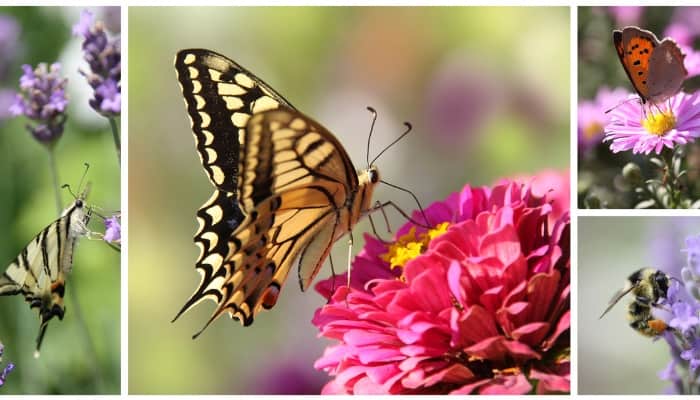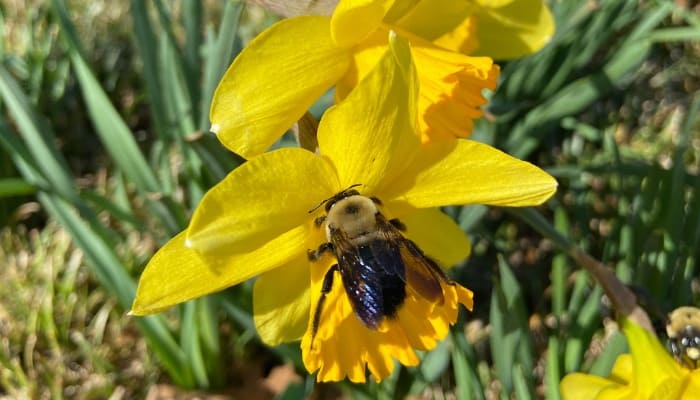Having lovely daffodils and beneficial pollinators in your garden are two of the most wonderful elements!
While most pollinators will visit your garden for other flowers, daffodils are great at attracting certain species, although they bloom too soon for other species to ever see their flowers.
Daffodils are good for pollinators, attracting them with their vibrant colors and strong fragrance. The most popular daffodils that pollinators love are Narcissus poeticus and Narcissus jonquilla. However, the hybridized versions lack pollen fragrance or nectar pollinators are looking for.
Continue reading to learn more about each pollinator variety, why pollinators are so important, and how daffodils play into their regular diet.
This article also covers why planting nonhybridized varieties are better for your garden and the pollinating species.
Daffodils and Pollinators – What To Know
Pollinators are necessary to transfer pollen and pollinate other flowers, which allows fruit and seeds to form.
Without them, we would not have fruit, berries, nuts, vegetables, or the beautiful flowers we all enjoy throughout our daily lives.
What Attracts Pollinators To Flowers?
There are a few reasons pollinators are attracted to flowers. Bright colors, sweet nectar, and fragrance are all major players in why pollinators visit flowers.
If a flower doesn’t entice them with color or scent or offer a treat to pollinators, they will pass it up.
What Pollinators Are Attracted to Daffodils?
Daffodils are great at attracting pollinators like hummingbirds, butterflies, moths, and beetles.
While they will attract most pollinating species, some prefer other flowers first, or they simply do not get the chance to pollinate a daffodil because they bloom so early in the spring.
Why You May Not See Any Pollinators on Daffodils
Pollinators don’t like the cold and go into hibernation during the cool season months.
Since the majority of daffodil varieties bloom first thing once the ground thaws, their blooms often come and go before the pollinators have come out to feed.
1. Weather Is Still Too Cold for Pollinators To Be Out
Bees, butterflies, most aviary species, and wasps can’t function in the cold and live in their hives or leave the area for warmer weather, hibernating until the weather warms at home.
2. Many Daffodils No Longer Attract Pollinators
Humans have worked to create larger blooms and unique color combinations that end up sacrificing pollen production, fragrance, and the nectar the flowers produce.
Many hybridized daffodil varieties have been hand pollinated or genetically crossed by humans for characteristics that please us, not the pollinators.
Look for natural or unhybridized varieties to ensure the best chance of having pollinators visit your daffodil garden!
Common Garden Pollinators
Numerous species contribute to pollination across the planet, and without them, we would be in trouble! Read more about how each pollinator plays a significant role in our ecosystem and your garden.

Bees
Bees pollinate everything from food-producing varieties to ornamental flowering species. When it comes to daffodils, they aren’t the biggest pollinator because many daffodils flower in the spring before bees wake up from hibernation.
Read more about how important bees are and how we are losing them at a significant rate here at the Bee Conservancy organization.
Wasps
While they are important pollinators, they do not pollinate as effectively as bees because they don’t have the same hairy bodies to transfer pollen.
Visiting flowers for their nectar is the main way they pollinate, carrying just a small amount of pollen to the other species they visit.
Hornets
Just like wasps, they do not have the hairy bodies bees do, but still, they visit flowers for the sweet nectar and to feed on smaller bugs. While they stop by other flowers, they do end up transferring pollen between plants.
Butterflies
Butterflies are common visitors of flowers to feed on sweet nectar, but due to their long legs, their bodies do not gather as much pollen since they do not touch the flower as much as bees do.
They make up for it by the fact that they visit so many flowers, carrying a wide variety of pollen from plant to plant.
Moths
Just like butterflies, moths don’t pollinate as effectively because their bodies are elevated from the flower.
Moths are important because they pollinate species in the evening and nighttime when most other insects are resting for the night.
Hummingbirds
Hummingbirds have highly evolved beaks and togues that allow them to drink plenty of nectar to supply their bodies with the energy they need for their high metabolism.
They are effective pollinators visiting countless species and carrying pollen on their beak and fathers.
Flies
Flies love anything sweet, so nectar is the name of their game! They also can function in cooler temperatures, unlike bees and other species.
They will visit daffodils in the early spring, feasting on the pollen and nectar, carrying it between plants.
Bats
Just as the moths do, bats take the night shift of pollination. They love to enjoy nectar and pollen, and their hairy bodies make them great transporters of the pollen.
The Mexican long-nose bat is the most common and has a modified nose for getting pollen from daffodils.
Certain Beetles
Certain beetles love to eat the floral parts of blooms. They are attracted to colors as they can identify them and will be most attracted to scented and fruity-smelling varieties.
While they eat the flowers, they will have pollen stick to them, which they transport to other flowers for pollination.
Native Birds
Native birds are usually trained to know the seasons and what species are blooming. While many do not rely on pollen for food, they seek out bugs to consume to provide them with energy.
In doing so they visit many different species carrying pollen around. In terms of daffodils, many birds may have flown south for the winter and have not returned to pollinate their blooms.
How To Attract Pollinators
Pollinators are vital to so much in our world, but sometimes they don’t have a reason or the resources to be in your area.
Attracting pollinators can be easy. Follow the tips below to attract pollinators to your garden to help cultivate a healthy ecosystem!
- Plant native species – Wildflower seed mixes are available that mimic natural species that grow in your area.
- If you can’t plant wildflower mixes, vary the species you plant. The more diversity in your plantings, the more reason to stop by your garden for a buffet of pollen and nectar!
- Add a bird bath, pond, or fountain to provide a source of water for pollinators to enjoy.
- Avoid using pesticides in your garden. Allowing the naturally beneficial insects and pollinators to thrive on their own will balance the food web, removing species that hurt your favorites and inviting pollinators nearby.
Related Questions:
Are All Daffodils Fragrant?
Many daffodil varieties are fragrant, but some are not. Natural species usually boast a lovely natural scent.
Narcissus thalia has the strongest fragrance, and Sir Winston Churchill won the Award of Garden Merit from the Royal Horticultural Society for its fragrance, long-lasting blooms, and easy growing ability.
Do Honey Bees Like Daffodils?
Since they bloom in the early spring, in most cases, they don’t attract honey bees. While you may notice bees stopping by, most bee varieties are still in hibernation or choose other species before they chose daffodils.
Conclusion
Without pollinators, the world would lose so many of the things that it is used to. Attract them to your garden with a diversity of flowers.
While daffodils are loved by pollinators, their blossoms don’t always last long enough to be visited. However, in unusually warm springs, you may be surprised by the number of tiny visitors that drop by!

